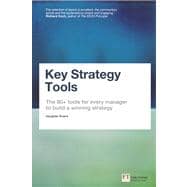
Vaughan Evans has been a strategy consultant since the mid-1980s, working with a broad range of corporate clients, from small firms to global giants, and with over 50 financier clients, both structured lenders and private equity. For the last ten years he has been independent, specialising in business strategy, business planning and strategic due diligence. Vaughan is a graduate of Downing College, Cambridge and a Sloan Fellow with distinction of London Business School. He has written four previous books including, The Financial Times Essential Guide to Writing a Business Plan.
Publisher's acknowledgements
Introduction
The Strategy Pyramid
How to use this book
Business vs corporate strategy
Section 1: Knowing Your Business
Overview
Essential tools
1. Identifying key segments
2. Issue Analysis (Minto)
Example: British Aerospace’s super segment
Useful tools
3. The 80/20 Principle (Pareto)
4. The Segmentation Mincer (Koch)
5. 5C Situation Analysis
6. SWOT Analysis
Section 2: Setting Goals and Objectives
Overview
Essential tools
7. Setting long-term goals
8. Setting SMART objectives
9. Maximising shareholder value
10. Balancing stakeholder interests
Example: Which goals count for RBS?
Useful tools
11. Creating Shared Value (Porter & Kramer)
12. Economic Value Added (Stern Stewart)
13. Balanced Scorecard and Strategy Map (Kaplan & Norton)
14. Core Ideology (Collins & Porras)
15. Business as a Community (Handy)
Section 3: Forecasting Market Demand
Overview
Essential tools
16. Sizing the market and Marketcrafting (Evans)
17. The HOOF Approach to Demand Forecasting (Evans)
Example: Galileo’s Hiccup in Market Demand
Useful tools
18. Smoothing through moving averages
19. The Income Elasticity of Demand
20. Survey methods of demand forecasting
a. Survey of customers’ intentions
b. Salesforce estimation method
c. The Delphi method
d. Pilot test marketing
21. Statistical methods of demand forecasting
a. Trend projection
b. Regression analysis
c. Barometric method (NBER)
Section 4: Gauging Industry Competition
Overview
Essential tools
22. The Five Forces (Porter)
23. Assessing customer purchasing criteria
24. Deriving key success factors
Example: Woolworths succumbs to the five forces
Useful tools
25. Weighing economies of scale
26. Corporate environment as a sixth force
27. Complements as a sixth force (Brandenburger & Nalebuff)
28. PESTEL analysis
Section 5: Tracking Competitive Advantage
Overview
Essential tools
29. Rating competitive position
30. The Resource and Capability Strengths/Importance Matrix (Grant)
Example: Cobra Beer’s clever competitive advantage
Useful tools
31. The Value Chain (Porter)
32. The Product/Market Matrix (Ansoff)
33. Cross,Spider and Comb Charts
34. Benchmarking
35. Structured interviewing
Section 6: Targeting the Strategic Gap
Overview
Essential tools
36. The Attractiveness/Advantage Matrix (GE/McKinsey)
37. The Growth/Share Matrix (BCG)
38. Profiling the ideal player
39. Identifying the capability gap
Example: Komatsu targets the cat
Useful tools
40. The Strategic Condition Matrix (Arthur D Little)
41. The 7S Framework (McKinsey)
42. The Opportunity/Vulnerability Matrix (Bain/LEK)
43. Brainstorming
44. Scenario planning
Section 7: Bridging the Gap: Business Strategy
Overview
Essential tools
45. Three Generic Strategies (Porter)
46. The Experience Curve (BCG)
47. Strategic repositioning and shaping profit growth options
48. Making the strategic investment decision
49. BlueOceanStrategy (Kim & Mauborgne)
Example: Could Facebook be undone the way it undid MySpace?
Useful tools
50. The Tipping Point (Gladwell)
51. The Price Elasticity of Demand (Marshall)
52. PIMS
53. The 4Ps Marketing Mix (McCarthy)
54. Product Quality and Satisfaction (Kano)
55. The Hierarchy of Needs (Maslow)
56. The Bottom of the Pyramid (Prahalad & Leiberthal)
57. Business Process Redesign (Hammer and Champy)
58. Outsourcing
Section 8: Bridging the Gap: Corporate Strategy
Overview
Essential tools
59. Optimising the Corporate Portfolio
60. Creating Value from Mergers, Acquisitions and Alliances
61. The Corporate Restructuring Pentagon (McKinsey)
62. Creating Parenting Value (Goold, Campbell & Alexander)
63. Core Competences (Hamel & Prahalad)
64. Strategically Valuable Resources (Collis & Montgomery)
Example: Virrce-based strategy
Useful tools
65. Strategically Distinctive Resources (Barney)
66. Distinctive Capabilities (Kay)
67. Distinctive Competences (Snow & Hrebiniak)
68. Dynamic Capabilities (Teece, Pisano & Shuen)
69. Deliberate and Emergent Strategy (Mintzberg)
70. Stick to the Knitting (Peters & Waterman)
71. Profit from the Core (Zook)
72. The Market-Driven Organisation (Day)
73. Value Disciplines (Treacy & Wiersema)
74. Disruptive Technologies (Christensen)
75. Coopetition (Brandenburger & Nalebuff)
76. Growth and Crisis (Greiner)
77. Good Strategy, Bad Strategy (Rumelt)
78. Innovation Hot Spots (Gratton)
79. Strategy as Orientation or Animation (Cummings & Wilson)
80. The Knowledge Spiral (Nonaka & Takeuchi)
81. The Eight Phases of Change (Kotter)
Section 9: Addressing Risk and Opportunity
Overview
Essential tools
82. Strategic Due Diligence and Market Contextual Plan Review (Evans)
83. The Suns & Clouds Chart (Evans)
Example: Were the Beatles worth the risk?
Useful tools
84. The Composite Risk Index and the 5x5 Risk Matrix
85. The Risk Management Matrix
86. Expected Value and Sensitivity Analysis
87. Black Swans (Taleb)
88. Strategy Bets (Burgleman & Grove)
Conclusion
References and Further Reading
Glossary
Index
The New copy of this book will include any supplemental materials advertised. Please check the title of the book to determine if it should include any access cards, study guides, lab manuals, CDs, etc.
The Used, Rental and eBook copies of this book are not guaranteed to include any supplemental materials. Typically, only the book itself is included. This is true even if the title states it includes any access cards, study guides, lab manuals, CDs, etc.